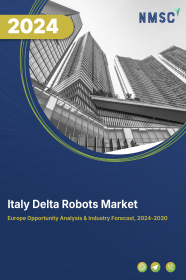
Italy Delta Robots Market by Axis Type (Double Axis, Three Axis, Four Axis, Five Axis, and Six Axis), by Payload Capacity (Up to 3 Kilogram, 3.1 to 8 Kilogram, 8.1 to 15 Kilogram, and More than 15 Kilogram), by Version Environment (Standard and Hygiene), by Application (Assembly, Pick & Place, Material Handling, Palletizing/Packaging, and Others), by Industry Vertical (Electronics, Cosmetics, Food & Beverages, Pharmaceuticals, and Others) – Opportunity Analysis and Industry Forecast, 2023–2030
Industry: ICT & Media | Publish Date: 02-Dec-2024 | No of Pages: 74 | No. of Tables: 59 | No. of Figures: 28 | Format: PDF | Report Code : IC899
Market Definition
Italy Delta Robots Market was valued at USD 23.01 million in 2022, and is predicted to reach USD 57.21 million by 2030, with a CAGR of 11.12% from 2023 to 2030. Delta or parallel robots are highly specialized robotic systems characterized by their unique mechanical structure and exceptional precision. These robots have three or more arms connected to a common base, forming a parallel mechanism that gives exceptional precision and structural stability.
Delta robots are renowned for their remarkable speed, agility, and accuracy, making them ideal for a wide range of high-speed, precision applications in manufacturing, electronics, food & beverage, pharmaceuticals, and others.
The design of delta robots allows them to move with incredible precision in all three dimensions, such as assembly lines, pick-and-place operations, and intricate manufacturing processes. Making them particularly well-suited for tasks involving pick and place, assembly, packaging, and material handling.
Their parallel kinematic structure, a robotic system design where multiple limbs work parallel to control end-effector motion, enabling precise coordination and control, provides superior rigidity and stability, ensuring consistent and reliable performance. Depending on their specific configuration, they can handle various payloads, ranging from lightweight items to heavier components.
Thus, delta robots are a class of robotic systems renowned for their speed, precision, and versatility. Their unique parallel structure, including rigidity, speed, and stability, makes them a preferred choice for various high-speed automation tasks across multiple industries, contributing to increased efficiency and precision in modern manufacturing and assembly processes.
Surge in Delta Robot Launches by Manufacturers Signals Rising Demand for Automation and Efficiency Across Industries
The escalating number of delta robot launches by manufacturers in the nation underscores a mounting demand for automation and efficiency across a wide spectrum of industries. This trend signifies a growing recognition among businesses of the transformative benefits offered by delta robots in optimizing processes, reducing human error, and meeting the heightened expectations for precision and productivity in modern industrial settings. As industries continue to prioritize automation as a means to stay competitive and enhance operational efficiency, the proliferation of delta robots exemplifies their pivotal role in driving these advancements.
For instance, in July 2023, ValTara SRL introduced the PKR-Dual Delta Robot Cell for the packaging industry. The PKR Dual Delta Robot Cell is designed with a compact and modular structure, enabling the seamless operation of both cells together or separately. This unique feature allows it to adapt to varying production demands, maximizing productivity and optimizing resource allocation, making it a valuable addition to the evolving landscape of industrial automation solutions.
Delta Robots Revolutionizing Italy's Food and Beverage Industry
Italy's esteemed food and beverage sector has embraced delta robots as indispensable tools for various critical tasks. These robots, known for their precision and cleanliness, play a pivotal role in packaging, sorting, and handling operations within the industry. Their ability to meet stringent food safety regulations ensures the integrity and hygiene of products.
Delta robots are favored for their unmatched speed and accuracy, making them ideal for delicate food handling and intricate packaging processes. This widespread adoption underscores their essential contribution to maintaining product quality, production efficiency, and compliance in Italy's thriving food and beverage industry.
The High Cost of Delta Robots Hinders Market Growth in Italy
The market for delta robots faces a significant impediment in the form of their high costs. These robots, renowned for their precision and efficiency, often carry a substantial price tag, which can pose a barrier to adoption for numerous businesses, especially those classified as small and medium-sized enterprises (SMEs).
Furthermore, the prolonged return on investment (ROI) period, resulting from these elevated upfront expenses, can discourage companies that seek more immediate cost reductions and efficiency enhancements. This scenario not only hampers market expansion but also contributes to market concentration, with only larger corporations having the financial capacity to both afford and capitalize on this advanced automation technology.
Integration of Advanced Technologies to Enhance Precision Represents a Significant Opportunity for the Market
Integrating advanced technologies, such as computer vision and artificial intelligence (AI), to enhance precision represents a significant opportunity for the delta robot market. These cutting-edge technologies enable delta robots to operate more accurately and efficiently, opening up new avenues for applications across various industries.
The integration of computer vision and AI not only enhances precision but also improves overall productivity and reduces errors in manufacturing processes. This can result in cost savings, higher product quality, and increased competitiveness for businesses that leverage delta robots with these advanced technologies. As industries continue to embrace automation and demand higher precision and flexibility, the delta robot market is poised to benefit significantly from the opportunities created by integrating computer vision and AI.
Competitive Landscape
The Italy Delta Robots industry includes several market players such as ABB Ltd., Fanuc Corporation, Kawasaki Heavy Industries Ltd, Yaskawa Electric Corporation, FESTO, Weiss GmbH, Omron Corporation, IGUS GmbH, Cama Group, and KUKA AG.
Key Benefits
-
The Italy Delta Robots market report provides a quantitative analysis of the current market and estimations through 2023-2030 that assists in identifying the prevailing market opportunities to capitalize on.
-
The study comprises a deep dive analysis of the market trend including the current and future trends for depicting the prevalent investment pockets in the market.
-
The information related to key drivers, restraints, and opportunities and their impact on the market is provided in the report.
-
The competitive analysis of the market players along with their market share in the Italy Delta Robots market.
-
The SWOT analysis and Porter’s Five Forces model are elaborated in the study.
-
Value chain analysis in the market study provides a clear picture of the stakeholders’ roles.
Italy Delta Robots Market Key Segments
By Axis Type
-
Double Axis
-
Three Axis
-
Four Axis
-
Five Axis
-
Six Axis
By Payload Capacity
-
Upto 3 Kilogram
-
3.1 to 8 Kilogram
-
8.1 to 15 Kilogram
-
More than 15 Kilogram
By Version Environment
-
Standard
-
Hygiene
By Application
-
Assembly
-
Pick & Place
-
Material Handling
-
Palletizing/ Packaging
-
Primary
-
Secondary
-
-
Others
By Industry Vertical
-
Electronics
-
Cosmetics
-
Food & Beverages
-
Pharmaceuticals
-
Others
Key Players
-
ABB Ltd.
-
Fanuc Corporation
-
Kawasaki Heavy Industries Ltd.
-
Yaskawa Electric Corporation
-
FESTO
-
Weiss GmbH
-
Omron Corporation
-
IGUS GmbH
-
Cama Group
-
KUKA AG
REPORT SCOPE AND SEGMENTATION:
|
Parameters |
Details |
|
Market Size in 2022 |
USD 23.01 Million |
|
Market Volume in 2022 |
1197 Units |
|
Revenue Forecast in 2030 |
USD 57.21 Million |
|
Growth Rate |
CAGR of 11.12% from 2023 to 2030 |
|
Analysis Period |
2022–2030 |
|
Base Year Considered |
2022 |
|
Forecast Period |
2023–2030 |
|
Market Size Estimation |
Million (USD) |
|
Growth Factors |
The escalating number of delta robot launches by manufacturers. The demand for delta robots in food industry. |
|
Companies Profiled |
10 |
|
Market Share |
Available for 10 companies |
|
Customization Scope |
Free customization (equivalent up to 80 working hours of analysts) after purchase. Addition or alteration to country, regional, and segment scope. |
|
Pricing and Purchase Options |
Avail customized purchase options to meet your exact research needs. |

















 Speak to Our Analyst
Speak to Our Analyst





















